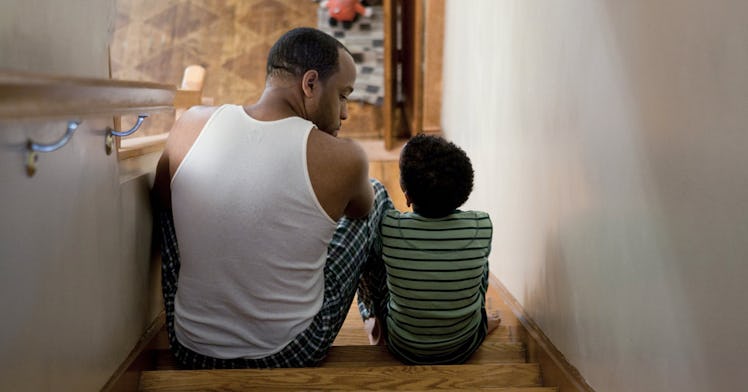How to Interrogate a Child You’re Pretty Sure is Lying
Interrogating a kid starts with empathy and evolves into to teachable moments to minimize lies

A child’s first lies are something to celebrate. Misdirection is an indication of brain development critical to the social and intellectual function of healthy (and occasionally dishonest) adults. With every lie, a young child solidifies their understanding of that other people have different thoughts and experiences than they do. Being untruthful also requires metacognition, or the ability to think about thinking. This usually starts coalescing around age 4, which means that older toddlers can’t always be trusted. They can, however, almost always be found out by a skilled parent-turned-interrogator. The key, experts explain, is to create a space in which they can admit guilt or solve the problems they create.
Sarah Wilson, a Portland, Oregon-based family and child counselor, explains that a child’s intentions are very rarely steeped in pure unadulterated evil. Often, she notes, lies are rooted in a desire to please. It’s a parent’s job to help a kid understand that honesty would please them more.
“A lot of times we set up scenarios that really encourage our kids to lie to us. We ask questions in a way that puts kids in a place of self-incrimination where they can’t plead the fifth,” says Wilson. “Going from empathy to teaching to repair, that’s a process that doesn’t really leave much room for lying. A kid wouldn’t feel the need to lie if they’re feeling understood and if the consequence was around understanding behavior and repairing wounds.
The parental instinct is to get to the root of a problem, to badger the kid with “why, why, why” is the adult equivalent of the child asking endless questions about the reason frogs are green. Instead, Wilson says, parents can ditch the endless questions and create a situation where kids are rewarded for telling the truth, even if that reward is just a simple, “I really appreciate you being honest with me.”
“With small children, you can’t browbeat them,” says Michigan-based Head Start supervisor Kelda Willson. “You have to teach them that it’s ok to make a mistake, and lying is a mistake. Otherwise, you’ll have a child who thinks ‘is it worth it? Am I willing to pay the price if I get caught?’”
And Willson explains that a teachable moment also requires a sense of calm and empathy from the parent. Sussing out a lie from a new liar is a game of good cop, good cop. But, truthfully, playing any kind of cop might be problematic according to research. In one study research compiled 125 false confessions to police and found 33 percent were given by juveniles. A more recent study suggested that police pressing children to answer questions they are reluctant to answer leads to inaccurate answers. So being successful at kid-lie detection is less about fancy interrogation tricks, per se, and more about just coming to understand the lie itself, the antecedents and the intention. But, Willson adds, parents should also give kids plenty of reasonable doubt.
The Four-Pronged Approach to Getting Kids to Tell the Truth
- Create a safe environment in which they can communicate openly about guilt or solve the problems they create.
- Provide connection and empathy to help a child be honest about their motivations and not try to hide their behavior.
- Reward kids for telling the truth, even if that reward is just a simple, “I really appreciate you being honest with me.”
- Find teachable moments to explain that lying is a mistake, and it’s ok to make mistakes.
“They go from one moment to the next,” says Willson. “Their three minutes is your half hour. We need to give them a little bit of credit for being a child.”
In her decades teaching Head Start kids, Willson also learned that often times employing a routine of psychological gymnastics tends to get to the truth a lot quicker than a stern line of questioning.
“What would I do if a child took my sharp scissors and hid them and I thought they did it, and I approached them and asked and they said ‘no no,’ but I think they have them? How do you get them to admit that?” Willson says. “I would try to trick them and say ‘I really need my scissors to do my work. I can’t do this, I can’t do that. I need them to be here.’ And the next thing you know, they’re there. They say, ‘You left them in my room.’ And I’d say ‘oh, you found them for me. Thank you very much. I will reward you for being truthful and fair.’ Focus on the positive, not the negative.”
Does that mean there’s a catch-all to get the truth out of your kid every single time? Of course not. But creating an environment where a child feels comfortable with exploring their own motivations — and one where you understand that sometimes motivations don’t even exist, to begin with — are key to a much more honest environment, and a much calmer one.
“Kids, when they’re in the stages of anger and frustration — in the reptilian brain — what they need first is connection and empathy,” says Sarah Wilson. “Before they can learn, they have to be in a place where their brain is calm. They need as much emotional control as that young brain can have. A parent who provides empathy and tries to understand those underlying emotions before integration tends to be a bit more honest about their motivations and don’t try to hide their behavior.”
This article was originally published on